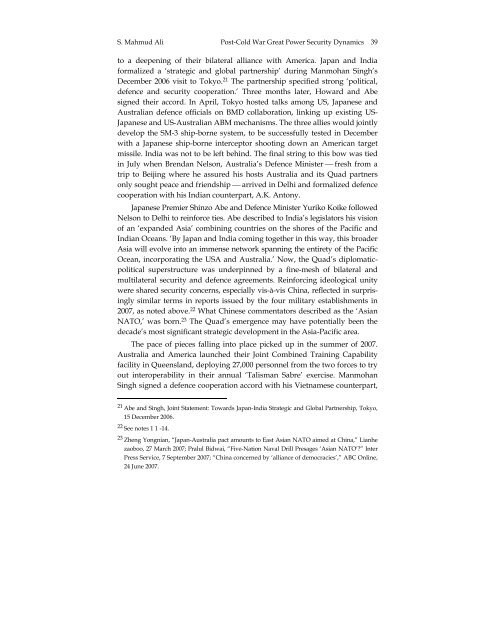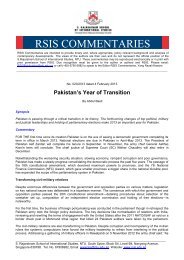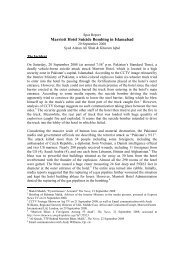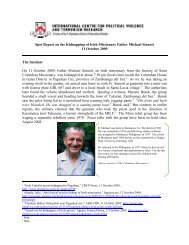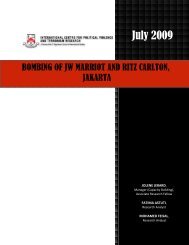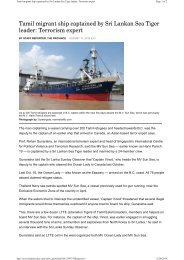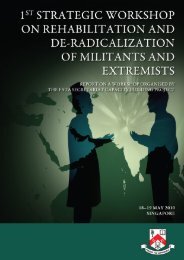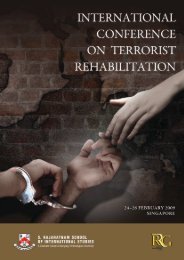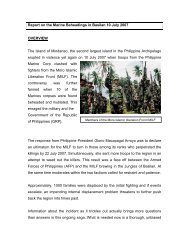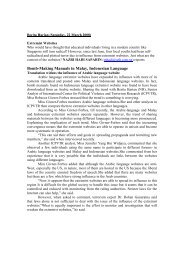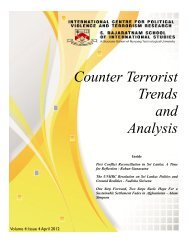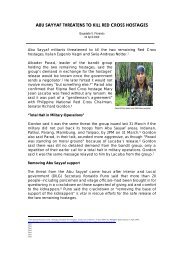Peace and Security Review, Vol.1 No. 2 - International Centre for ...
Peace and Security Review, Vol.1 No. 2 - International Centre for ...
Peace and Security Review, Vol.1 No. 2 - International Centre for ...
Create successful ePaper yourself
Turn your PDF publications into a flip-book with our unique Google optimized e-Paper software.
S. Mahmud Ali Post-Cold War Great Power <strong>Security</strong> Dynamics 39<br />
to a deepening of their bilateral alliance with America. Japan <strong>and</strong> India<br />
<strong>for</strong>malized a ‘strategic <strong>and</strong> global partnership’ during Manmohan Singh’s<br />
December 2006 visit to Tokyo. 21 The partnership specified strong ‘political,<br />
defence <strong>and</strong> security cooperation.’ Three months later, Howard <strong>and</strong> Abe<br />
signed their accord. In April, Tokyo hosted talks among US, Japanese <strong>and</strong><br />
Australian defence officials on BMD collaboration, linking up existing US-<br />
Japanese <strong>and</strong> US-Australian ABM mechanisms. The three allies would jointly<br />
develop the SM-3 ship-borne system, to be successfully tested in December<br />
with a Japanese ship-borne interceptor shooting down an American target<br />
missile. India was not to be left behind. The final string to this bow was tied<br />
in July when Brendan Nelson, Australia’s Defence Minister ⎯ fresh from a<br />
trip to Beijing where he assured his hosts Australia <strong>and</strong> its Quad partners<br />
only sought peace <strong>and</strong> friendship ⎯ arrived in Delhi <strong>and</strong> <strong>for</strong>malized defence<br />
cooperation with his Indian counterpart, A.K. Antony.<br />
Japanese Premier Shinzo Abe <strong>and</strong> Defence Minister Yuriko Koike followed<br />
Nelson to Delhi to rein<strong>for</strong>ce ties. Abe described to India’s legislators his vision<br />
of an ‘exp<strong>and</strong>ed Asia’ combining countries on the shores of the Pacific <strong>and</strong><br />
Indian Oceans. ‘By Japan <strong>and</strong> India coming together in this way, this broader<br />
Asia will evolve into an immense network spanning the entirety of the Pacific<br />
Ocean, incorporating the USA <strong>and</strong> Australia.’ <strong>No</strong>w, the Quad’s diplomaticpolitical<br />
superstructure was underpinned by a fine-mesh of bilateral <strong>and</strong><br />
multilateral security <strong>and</strong> defence agreements. Rein<strong>for</strong>cing ideological unity<br />
were shared security concerns, especially vis-à-vis China, reflected in surprisingly<br />
similar terms in reports issued by the four military establishments in<br />
2007, as noted above. 22 What Chinese commentators described as the ‘Asian<br />
NATO,’ was born. 23 The Quad’s emergence may have potentially been the<br />
decade’s most significant strategic development in the Asia-Pacific area.<br />
The pace of pieces falling into place picked up in the summer of 2007.<br />
Australia <strong>and</strong> America launched their Joint Combined Training Capability<br />
facility in Queensl<strong>and</strong>, deploying 27,000 personnel from the two <strong>for</strong>ces to try<br />
out interoperability in their annual ‘Talisman Sabre’ exercise. Manmohan<br />
Singh signed a defence cooperation accord with his Vietnamese counterpart,<br />
21 Abe <strong>and</strong> Singh, Joint Statement: Towards Japan-India Strategic <strong>and</strong> Global Partnership, Tokyo,<br />
15 December 2006.<br />
22 See notes 1 1 -14.<br />
23 Zheng Yongnian, “Japan-Australia pact amounts to East Asian NATO aimed at China,” Lianhe<br />
zaoboo, 27 March 2007; Pralul Bidwai, “Five-Nation Naval Drill Presages ‘Asian NATO’?” Inter<br />
Press Service, 7 September 2007; “China concerned by ‘alliance of democracies’,” ABC Online,<br />
24 June 2007.<br />
<strong>Vol.1</strong>, <strong>No</strong>.2 2008 pp.27-47


